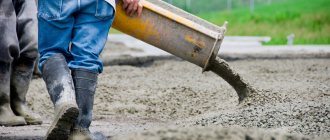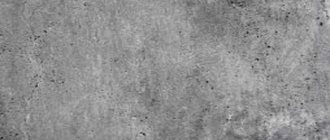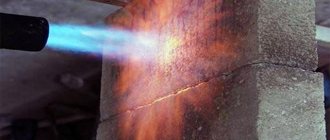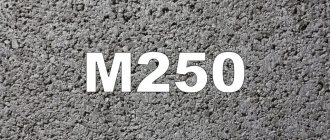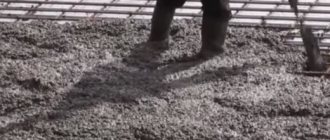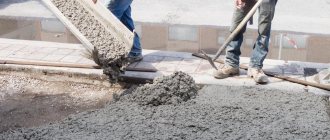Home |Construction |What is concrete shotcrete?
Date: March 13, 2017
Comments: 1
When carrying out construction activities related to increasing the strength characteristics of building structures and restoring objects, advanced technologies are used. One of the popular methods allows you to apply a special composition under pressure to reinforced concrete or reinforcement cages - shotcrete concrete. The material is a sand-cement mixture, the concentration of sand in which is from 2 to 6 times higher than the proportion of cement.
Shotcrete is a concrete solution that, using special equipment under a pressure of about 0.5 MPa at a speed of more than 100 meters per second, forms a monolithic base, completely filling cavities, cracks and pores. Concreting produced using this method allows you to create a durable coating that is resistant to mechanical stress, moisture penetration and temperature changes.
Over the past 100 years, concrete spraying technology has evolved from innovative to classical and is used in a number of industries to solve various production problems.
The process of layer-by-layer application of concrete mortar supplied under pressure is called shotcrete or shotcrete. Let's take a closer look at concrete shotcrete, focusing on the technology, equipment used, and area of use.
Let's get acquainted with the method
When experts use the construction term “shotcrete”, many find it difficult to answer what it is. In fact, concrete shotcrete is a method of forming concrete surfaces of complex configurations without the use of formwork.
In this case, the solution is supplied:
- At pressure increased to 0.4-0.6 MPa.
- With feed speeds up to 150 meters per second.
The method of applying the working mixture allows you to effectively fill potholes, microcracks, cavities, and also form an array of increased density. This has a positive effect on increasing the strength characteristics, provides reliable waterproofing protection, and makes the array resistant to negative temperatures. The technology of applying the concrete composition ensures high adhesion of the mixture and reduces the loss of solution associated with splashing.
The use of shotcrete is quite common today
A distinctive feature of the technology is the ability to carry out activities in places with limited access, which is due to the use of flexible pipelines for supplying concrete mixture. The distance from the point of supply of the composition to the concrete mass is about 100 cm.
The method of shotcreting a concrete mixture is in demand when strengthening the vaults of objects located below the zero level. It is also used in the processing of tank walls, construction of mines, swimming pools, and transport tunnels.
Tunneling
You simply cannot do without shotcrete when building tunnels. When laying roads in mountainous areas and constructing subways, such qualities of the method as the speed of application and hardening of layers are especially valuable, which can significantly speed up the pace of construction. And, of course, the high adhesion of the fine-grained mixture, which is simply invaluable in the construction of thin-walled domed vaults. The dense structure guaranteeing high strength is ideal for underground structures experiencing constant groundwater pressure. The use of reinforcing mesh, steel frames and anchors makes it possible to build tunnels of gigantic proportions. Another undeniable advantage is the ease of transporting concrete to the work site. For a long and thin installation hose, bottlenecks are not an obstacle. The compactness of the equipment does not cause problems with its transportation to high mountain areas. Thus, it was shotcrete that was used in Vietnam in the construction of tunnel hydroelectric power stations. Many world capitals intend to use shotcrete for the construction of new metro lines, and this is quite logical. Since all of the above advantages can significantly reduce the construction budget and extend the service life of structures. It is important that shotcrete is preferred in regions with increased seismological activity. After all, technology allows you to add certain additives to the mixture to make the material more plastic. And this makes the technology truly universal.
Advantages of technology
The process of mechanized supply of shotcrete concrete allows spraying under pressure a self-compacting mixture with an aggregate size of up to 1 cm. The high intensity of application of the composition forms a dense concrete mass in which there are no cavities. This has a positive effect on improving the mechanical characteristics of the concrete layer, increasing the service life of the structure being built.
Shotcrete has a number of serious advantages compared to the manual method. Thanks to the peculiarities of the technology, a concrete layer is formed with the following characteristics:
- increased density of the massif, in which there are no cavities;
It is widely used in the non-ferrous, ferrous, chemical, cement and glass industries, each of which is associated with high-temperature processes
- resistance to negative temperatures;
- low coefficient of water absorption caused by the resistance of the concrete mass to moisture absorption;
- significant resistance to loads, including immediately after formation;
- improved adhesion, thanks to which the composition can be applied to vertical walls without the use of formwork;
- resistance to open fire, as well as aggressive compounds and chemicals.
In addition, the technology allows:
- Inject shotcrete concrete onto various surfaces, regardless of their location, which is achieved due to improved adhesion and load-bearing capacity of the material.
- Apply a layer of material of varying thickness in accordance with the specific tasks and actual conditions of the construction site.
- Apply the composition to surfaces that have significant unevenness.
- Form reinforced structures from gunite concrete.
- Reduce the time required for the construction of building structures without the use of formwork forms due to increased productivity.
- Significantly reduce the costs associated with concreting due to reduced consumption of a mixture with increased strength.
The technique is used for securing soil during above-ground construction.
Construction of swimming pools
The construction of swimming pools and reservoirs is another area where shotcrete is a priority way of working. An area where it is absolutely impossible to do without a good gunite installation. Conventional plastering, which is sometimes resorted to when building a swimming pool, is fraught with the fragility of the structure. Even when using a mechanized method, sufficient adhesion of the material to the reinforcing mesh is not possible. Applying the material under low pressure will inevitably lead to sagging and peeling. Neither the ceramic tiles laid on top nor the waterproofing coating used in the work can prevent such a result. Only a tightly pressed concrete solution can cope with the task. Indeed, in this case, the concrete will experience load both from the soil and from the water. This double compression of the walls necessitates the use of especially durable materials and the most reliable methods of laying them. The latest generation of shotcrete guns make it possible to use all kinds of additives to improve the process. Submitted under high pressure, each new thin layer of concrete squeezes out the moisture from the previous one. As a result, quartz sand and the binding elements of the last layer close the slightest voids, creating a durable wall that can withstand high loads for many years. Thanks to shotcrete, the owner will not have to carry out repair and maintenance work to strengthen the walls of the hydraulic structure, and this is a significant saving of time and money. However, shotcrete can also be carried out during a major overhaul of a pool built in a different way so that such work does not have to be carried out in the future.
Scope of application
Shotcrete is used for the following purposes:
- increasing the strength characteristics of structures made of reinforced concrete;
- repair of concrete surfaces;
- eliminating local defects;
- formation of vaults of mine structures;
- construction of embankments;
- strengthening slopes;
- construction of hydraulic facilities, tanks;
- formation of thin-walled dome-type surfaces;
- sealing of collectors and underground tunnels;
- applying mixtures that have fire-resistant characteristics and are used for lining;
- creating decorative objects with a curved surface.
The technology is widely used in the mining, tunneling, metallurgical industries, as well as in the construction, glass and chemical industries.
When shotcrete is applied, the technology has certain features, including the ability to apply the composition to uneven surfaces, as well as bases located in any planes
The widespread introduction of a progressive method used to solve a wide range of serious problems is facilitated by the achievements of professional builders. They optimize the recipe, granulometric composition, and introduce special modifiers, thanks to which shotcrete concrete acquires various properties.
What is needed for shotcrete
To complete the work you will need:
- A device that allows a gunite mixture to be supplied under pressure to a spray nozzle.
- A compressor that gives the solution the required speed necessary for self-compacting concrete during application.
- The source of water supply required to supply water.
- A trained specialist who applies the solution when forming the surface.
- Shotcrete concrete, the recipe of which corresponds to the specifics of the tasks performed.
Reconstruction of waterworks
Repair of hydraulic structures is always associated with a number of certain difficulties. Firstly, there is always a stop in activity and water supply. This means downtime, economic losses, plus user inconvenience. This is where shotcrete can demonstrate its best qualities. It is this type of concreting that helps complete the task super quickly. The time that you need to wait after spraying is also short. There are special supplements that reduce this time to a minimum. The fact that shotcrete is the best means for reconstructing waterworks has been proven in practice more than once. In particular, workers face a number of difficulties during the repair of irrigation canals, which are located on the mountainside and are the largest agricultural arteries in the region. Cracks that appear during long-term operation lead to global water losses and landslides. Inserts made of polymer materials turn out to be ineffective, easily damaged and soon leak. Conventional concreting involves blocking the channel for several weeks, which is not possible, given the specifics of the object. In such cases, shotcrete can come to the rescue. After all, the hygroscopic properties and strength of shotcrete are completely suitable for such work.
Equipment selection
Shotcrete coating is carried out using special devices. The question of choosing the optimal equipment for performing activities depends on a number of factors:
- method of performing work;
Equipment for shotcreting concrete is manufactured in the form of individual units and devices or be complex in nature and represent a shotcrete installation
- volume of mixture to be distributed;
- specific conditions of the construction site.
The technology allows you to apply shotcrete concrete to the surface being formed using an installation that includes:
- compressor;
- supply main system;
- gun (nozzle) for shotcrete.
An important aspect when choosing a spraying machine is mobility. Also, pay attention to the possibility of performing work in a confined space and the design of the nozzle, which determines the degree of rebound of the solution.
Construction of drainage systems
Of course, shotcrete is ideal for constructing drainage systems. After all, here the material is subject to all the requirements that shotcrete easily satisfies. Waterproofing properties, hardening speed, high adhesion even on curved surfaces, the ability to work without formwork, the ability to deliver solutions to narrow and difficult places, resistance to various temperature conditions. All this makes shotcrete the most suitable type of organization of a drainage system. Whether we are talking about an industrial scale or a small residential building, each volume has its own torquet installation, which can be powered either from the network or from a generator or construction equipment running on fuel. The main thing is to purchase quality equipment with a guarantee. Large companies that manufacture or sell shotcrete guns provide customer training and service support. With proper use and universal configuration, one shotcrete installation pays for itself many times over in a very short period of time. After all, the list of its capabilities includes a whole range of works that other construction equipment cannot do. That is why more and more customers are choosing shotcrete for the repair of hydraulic structures and the construction of various water pipelines. We must assume that the demand for this service will only grow over time. After all, equipment, machine modifications and mixture compositions are being improved, keeping pace with rapid technological progress.
Types of spraying process
The technology provides the following methods of spraying the solution:
- Dry, which involves preliminary mixing of ingredients and special modifiers, which are transported through lines to the nozzle under the influence of compressed air, and moistened before release. The method makes it possible to form a dense array with a high degree of adhesion in one pass. However, it has its drawback - when applied, up to 20% of the solution rebounds.
Depending on the state of aggregation of the initial mixture, it is customary to distinguish between dry and wet shotcrete methods, the names of which correspond to the degree of moistening of the material before it is fed to the nozzle
- Wet, implemented by supplying a pre-prepared concrete solution to the nozzle while simultaneously supplying pressurized air at the outlet. Rebound reduced to 10%. The method allows the use of industrially produced concrete mixtures.
Preparing the mixture
When preparing shotcrete concrete, follow these recommendations:
- Sift the ingredients before use using a sieve with mesh up to 10 mm.
If you decide to use shotcrete, it is recommended to study the composition of the mixture first
- Follow the recipe when preparing the sand-cement mixture in a ratio appropriate to the coating conditions.
- Mix cement with sand in a ratio of 1:2 or 1:3 if the surface is subject to impact.
- Prepare the composition in a ratio of 1:4 in the absence of abrasive forces and operation under atmospheric conditions.
- Prepare the sand-cement mixture at the work site or deliver it using vehicles.
- Allow no more than 3 hours between preparation and use.
Application of the solution
Carry out shotcrete at an air temperature exceeding 5 °C, following the technology:
- Apply the solution in layers, ensuring an interval of 0.8-1 m from the nozzle to the surface to be treated.
- Control the layer thickness of 2-4 cm.
- Make sure that the nozzle is perpendicular and should be moved in a spiral.
- Apply subsequent coats at 30 minute intervals.
- Rinse and air-blow hoses and equipment.
Shotcrete concreting of a house
At home, to perform shotcrete, you need to assemble the following set of equipment: a compressor, a gearbox, a “pneumatic shovel” (a holder with a metal bucket at the end). The cement composition is first sucked into the shovel, then pushed through the sprayer onto the surface to be treated with compressed air (pressure is 4-6 atmospheres).
Due to the size of the bucket holes, concrete is applied using the wet method, the particle size being up to 6 millimeters. The distance from the nozzles to the surface should be 10-15 centimeters, the layer is made with a thickness of 0.5 to 1.5 centimeters.

